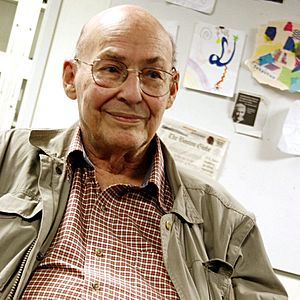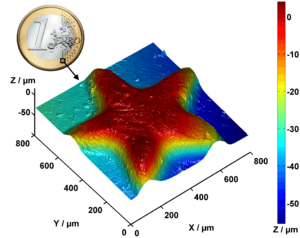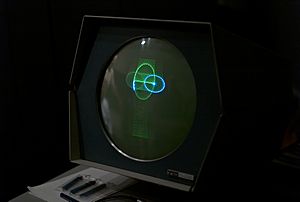Marvin Minsky facts for kids
Quick facts for kids
Marvin Minsky
|
|
|---|---|

Minsky in 2008
|
|
| Born | August 9, 1927 New York City, New York, U.S.
|
| Died | January 24, 2016 (aged 88) Boston, Massachusetts, U.S.
|
| Education | Harvard University (BA) Princeton University (MA, PhD) |
| Known for |
|
| Spouse(s) |
Gloria Rudisch
(m. 1952) |
| Children | 3 |
| Awards |
|
| Scientific career | |
| Fields | |
| Institutions | Massachusetts Institute of Technology |
| Thesis | Theory of Neural-Analog Reinforcement Systems and Its Application to the Brain Model Problem (1954) |
| Doctoral advisor | Albert W. Tucker |
| Doctoral students |
|
| Influenced | David Waltz |
Marvin Lee Minsky (born August 9, 1927 – died January 24, 2016) was an American computer scientist. He was a very important researcher in the field of artificial intelligence (AI). AI is about making computers think and learn like humans. Minsky also helped start the AI laboratory at the Massachusetts Institute of Technology (MIT). He wrote many books about AI and how the mind works.
Minsky received many awards for his work. One of the most important was the Turing Award in 1969. This award is like the Nobel Prize for computer science.
Contents
Biography
Marvin Lee Minsky was born in New York City. His father was an eye surgeon, and his mother was an activist. He went to several schools, including Phillips Academy. From 1944 to 1945, he served in the United States Navy.
He studied mathematics at Harvard University, earning his bachelor's degree in 1950. He then went to Princeton University and received his Ph.D. in mathematics in 1954. His Ph.D. paper was about how brain-like systems could learn.
In 1958, Minsky joined the faculty at MIT. A year later, he and John McCarthy started what is now called the MIT Computer Science and Artificial Intelligence Laboratory. This lab became a leading place for AI research. Minsky was a professor of media arts, electrical engineering, and computer science at MIT.
Contributions to Computer Science
Marvin Minsky created many important inventions. In 1963, he made the first head-mounted graphical display. This was a very early version of virtual reality headsets. In 1957, he invented the confocal microscope. This type of microscope is now widely used to get clear 3D images of tiny things.
He also worked with Seymour Papert to develop the first "turtle" for the Logo computer language. This turtle was a small robot that could draw lines. In 1951, Minsky built SNARC, which was one of the first machines to learn using a network of artificial "neurons."
Minsky and Seymour Papert wrote a famous book called Perceptrons. This book looked closely at how artificial neural networks work. These networks are computer systems inspired by the human brain. The book was very important in the early days of AI.
Minsky also came up with other AI ideas. His idea of "frames" helped computers organize and understand knowledge. This idea is still used today. He also thought about whether extraterrestrial life might think like humans, which could help us communicate with them.
The Society of Mind
In the early 1970s, Minsky and Papert started working on the Society of Mind theory. This theory tries to explain how human intelligence works. It suggests that our intelligence comes from many simple, non-intelligent "agents" working together.
Minsky got many ideas for this theory from trying to build a robot. This robot used a robotic arm, a camera, and a computer to build things with children's blocks. In 1986, Minsky wrote a book called The Society of Mind for everyone to read. It explained his theory in detail.
- The MA-3 Robotic Manipulator Arm, on display at MIT Museum
In 2006, Minsky published another book, The Emotion Machine. This book explores how human minds work and suggests new ideas about emotions. You can find parts of this book for free on his website.
Personal Life
In 1952, Marvin Minsky married Gloria Rudisch, who was a pediatrician. They had three children together. Minsky was also a very good piano player. He often thought about how music and the mind are connected.
Minsky believed that computers would one day become more intelligent than most people. However, he thought it was hard to guess how quickly this would happen. He also believed that AI systems would be tested carefully before being used widely.
Awards and Affiliations
Marvin Minsky received many important awards for his work. These include:
- The Turing Award in 1969 (the highest honor in computer science)
- The Japan Prize in 1990
- The Benjamin Franklin Medal in 2001
- The BBVA Foundation Frontiers of Knowledge Award in 2013
- He was also inducted into the Computer History Museum's Hall of Fame in 2006.
Minsky was a member of several important groups, including:
- United States National Academy of Engineering
- United States National Academy of Sciences
- Alcor Life Extension Foundation's Scientific Advisory Board
Death
Marvin Minsky passed away on January 24, 2016, at the age of 88, due to a brain hemorrhage.
Media appearances
- Future Fantastic (1996)
- Machine Dreams (1988)
See also
 In Spanish: Marvin Minsky para niños
In Spanish: Marvin Minsky para niños





